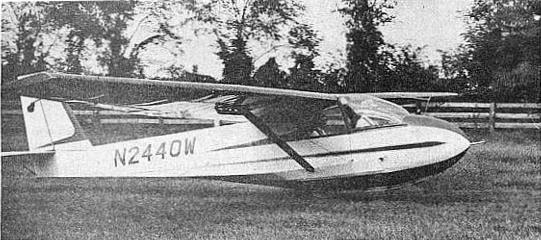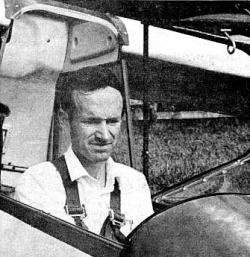
Public Site
| Members only: Restricted Docs Membership Biographies Your Account Your Flights Mailing Lists Badges Board Notes CrossCountry Instructors Logsheets Students Tracking Admin |
|
Aloft In a Sailplane
Flying Without Power: Warrenton Becomes Capital's Soaring Center By PAUL SULLIVAN |
||
|
A novel business moved to Faquier this month, bringing with it a new title for the Warrenton community: Soaring Center for the Nation's Capital. The venture is a Capital Area Soaring School Inc., formerly operating from Godfrey Field, Leesburg. Owners Gordon Bogora and Ernie Klimonda shifted the school, its four sailplanes and two power planes, to Warrenton Airpark south of Warrenton last Wednesday to escape the increasing traffic at Leesburg. Soaring is flying in motorless aircraft. Followers of the sport are enthusiastic, and its ranks include many flyers of conventional planes. During the past year, 300 pilots flew with the school, half of them students working toward a sailplane license. The school offers certified instruction, rents aircraft, provides towing service (sailplanes must be towed aloft behind a power plane), and holds a dealership for Schweizer sailplanes. Sailplanes, more trim and graceful than ordinary aircraft, offer man the closest flying to |
that of the birds -- quiet, vibrationless, safe and with less feeling of effort. A flight last Wednesday with Ernie Klimonda, 20 years a glider pilot, emphasized the appeal of powerless flight. The weather was fine: a little breeze, high scattered clouds, balmy temperature. The ship was a Schweizer 2-33, featuring two seats, and used for training purposes. On the End of a Line Taking off in the sailplane is like riding a bicycle: an assistant is required to hold the ship's wing horizontal. Little run is required before the towed machine is bouncing into the air off te last big bump on the grass strip. The tow is uneventful, we climb out in the direction of Warrenton, gaining about 350 feet per minute at an airspeed of 80 miles per hour. Taking a look around, we find confidence in the long, sturdy wings, each braced from the fuselage. Controls are simple: a joystick used with conventional rudder pedals. Add a |
tow line release handle and a handle for the mechanically-actuated dive brakes which are located under either wing and which are brought into use to provide rapid descent. Sailplanes are lightweight, their wings provide great lift, and it can be a problem at times to bring them down fast enough, hence the dive breaks,or "spoilers". Elsewhere in the cockpit, instruments are few: an airspeed indicator, altimeter, turn-and-bank indicator, and a variometer. The latter instrument gives a sensitive readout of the craft's rate of climb or descent. Gentle Rushing of Wind When the tow leaves and nature takes over, there isn't the slightest feeling of helplessness for lack of an engine: At the sailplane's 45-mile-per-hour cruising speed we are losing only about 100 feet per minute and that can be detected only |
 A ONE-POINT LANDING, the proper kind for a sailplane,
is executed at
A ONE-POINT LANDING, the proper kind for a sailplane,
is executed at Warrenton Airpark. Note extended wing air spoilers near strut. |
||
|
by the instruments, not the eye. The air is stable, the ride comfortable, and there's a fine view of the countryside. In all, there is a feeling of freedom. But the best is yet to come. For the first 10 minutes our flight amounts to a gradual loss of altitude -- after all, we have no engine and nature is keeping us up. But the veteran flyer is casting about for a vertical hitch-hike, a way to cheat gravity. Over a field of corn stubble we find a thermal -- an invisible column of heated air rising thousands of feet into the sky. The altimeter had shown about 2400 feet, but halts as Klimonda tilts the Schweizer into a steep right turn to stay within the thermal. Instead of a gentle descent, the sailplane is now in a moderate climb. The variometer shows us to be ascending at between 200 and 300 feet per minute. Just like big bird, lazily floating up, up, up. Above, and some distance off, another sailplane is released and begins to poke about the sky for lift. In minutes the pilot of the second ship noticed our good fortune and wafts onto the magic escalator not far above us. Together, our two birds continue to climb on their 50-foot pinions, circling around, above and below one another. Straight Down, Then Up |
lease -- Klimonda elects to leave the thermal. Off we sweep, away from air traffic, where the pilot aims to try a few aerobatics -- stunts. The little ship handles stalls and moderate maneuvers like a champ. Capping things off Klimonda tries a loop. Stick way forward, the nose drops and airspeed picks up rapidly to just past the ship's 100mph "redline". Then it's stick hard back. The nose up fast and . . . Warrenton is suddenly above us in the view through the windsheid. The nose "falls through" and we're momentarily diving vertically on someone's barn before the nose comes up and assumes its normal attitude near the horizon. It's all over too soon. Our host spots the grassy strip on the C.E. Beatley farm, swings into the landing pattern and pops the dive brakes. We slip silently over farmyards, low enough tos ee wash on the lines and dogs peering at us. We bank over treetops to line up with the strip and our speed becomes noticable, even rapid. Stop, On One Wing |
tiring moth, the ship droops on one wing. Rides are avilable at $9 a shot and last from 10 to 20 minutes, but anyone with a yen for flying should be warned that soaring can be addictive. The "cure" (temporary) costs $375 and buys enough soaring for a license. Power pilots can take a cheaper route for transition, costing $175. Capital Area Soaring School operates Wednesdays, weekends and holidays but instruction is not offered from December 14 through mid-March. During the midwinter the pros of the sport continue to fly, taking advantage of our ripe weather conditions which provide so-called wave soaring over the Blue Ridge. There, noted Mr. Klimonda, altitudes of 17,000 feet have been attained. Soaring, it seems is not (only) for the birds. |
 THE OLD LOOP-THE-LOOP at amusement parks was tame stuff compared with a
tight loop in a sailplane. The view is straight down through the
windshield. That's a barn and cornfield below.
THE OLD LOOP-THE-LOOP at amusement parks was tame stuff compared with a
tight loop in a sailplane. The view is straight down through the
windshield. That's a barn and cornfield below.
|

NOW THAT RIDE'S OVER, Reporter Sullivan, former power pilot,
wishes he had a glider. -- Photo by Pierre Mion |
|
Original Article (470k) |
|||||
| Return to Chapter II | |||||
| Foreword, Acknowledgements, Introduction & Overview | Chapter I The Beginnings |
Chapter II Capitol Area Soaring School |
Chapter III Warrenton Soaring Center |
Chapter IV Skyline Soaring Club, New Market |
Chapter V Skyline Soaring Club, Front Royal |